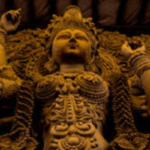Yogaś citta vŗitti nirodhaḥ.
- Yogaś – Yoga
- citta – mind
- vṛtti – modifications, activity
- nirodhaḥ - cessation
Yoga is the cessation of the movements of the mind.
Patanjali defines yoga as the cessation of the thoughts in our minds. In the Tantric view, Pure Consciousness is at the root of our minds. It is the very power of knowing, a Divine knowing that has the potential to know everything. Yet when Pure Consciousness takes the form of our minds, its power is vastly reduced. Our minds lack the Divine Powers the Absolute has. A goal of yoga is to return to this expanded state of Pure Consciousness that lies latent within our minds. When Pure Consiousness moves, it does so as śakti, conscious Divine energy. When our minds have movements—which Patanjali calls vṛittis—they too are a form of śakti, but their divine origin is concealed. Vṛittis are the infinite shapes and forms our minds take through our thoughts, which conceal our essential nature.
The phrase citta vṛtti nirodhaḥ is at the heart of the Yoga Sutras. It is usually translated as the cessation of the thought waves of the mind, implying that yoga is a conscious effort to still our thoughts. Another way to state this is to say that yoga is the path of recognizing the intrinsic emptiness of the mind, an emptiness beyond thought that always exists within our thinking mind. A still or empty mind reflects the Pure Awarenes that is the underlying essential nature of our minds.
It’s the nature of our minds to think. We need our minds to navigate the material world we live in. However, our thoughts conceal something deeper within our own beings. Identifying with our thoughts, we don’t recognize our deeper essence. Patanjali and the seers of the wisdom traditions have thus given teachings on how to meditate, to gently take our attention away from the thoughts in our minds through a process of concentration and resting in our inherent Awareness. Concentration in meditation focuses our minds, piercing through the random thoughts that perpetually emerge and subside. Resting in Awareness, we see that Pure Awareness always exists within the background of our thinking minds.
There are many methods of meditation. Many utilize the breath as a central feature. When our breath is steady and regular, our minds become steady and our thoughts slow down. Conversely, when our minds are distracted and led by our thoughts, our breath becomes shallow, irregular and erratic. Watching the breath, allowing it to naturally rise and fall, rise and fall, is a basic component of meditation that forms a foundation for easing the mind. Slowly through meditation, we become aware of that which witnesses our thoughts, the Seer, the deep I AM consciousness—Pure Awareness–that is the essence of our beings.
Exercise
Sit in a comfortable meditative posture, on the floor or in a chair. Our backs should be relaxed, but straight, our breathing easy. Now watch the thoughts play in our minds for a few minutes. Try not to buy into them, but watch them come and go, come and go, and give rise to new thoughts that also come and go. After some time, try to stop them. Can you do it?
Now sit in the same meditative posture and watch your breath come in and go out in a natural rhythm. Feel the breath coming in as we inhale and go down deep into our lower abdomen and pause momentarily. Then see the breath rise as we exhale and visualize it moving toward the top of our heads. There is another momentary pause at the end of our exhale before another inhale starts. Now watch the breath go down again toward our lower abdomen. Continue this for several minutes, slowly inhaling and exhaling and watching the breath rising and falling. After some time, begin to notice your thoughts. Are they as active as usual? Can you see a difference in the amount and intensity of the thoughts in your mind?








